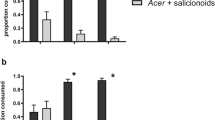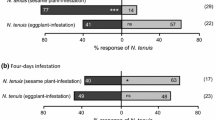Abstract
Onion fly females,Delia antiqua (Diptera: Anthomyiidae) laid the most eggs on ovipositional dishes havingn-dipropyl disulfide (Pr2S2) release rates of 1–6 ng/sec from polyethylene capsules placed beneath a sand substrate. When dipropyl disulfide was released from the wax coating of surrogate foliage rather than from the substrate, ovipositing females again responded differentially to various concentrations, laying more eggs around stems containing 0.075 and 0.089 mg/stem. Factorial combinations of several concentrations released from surrogate foliage and substrate showed that releases from surrogate foliage stimulated four times more egg-laying than releases from the substrate. Females tended to lay more eggs around surrogate stems having Pr2S2 at the base rather than on the upper half of foliage. Observations of individual females performing preovipositional examining behaviors on Pr2S2-treated surrogate stems indicated that females tended to land on the upper portions of the foliage, but after landing, spent most of their time examining areas of soil and surrogate within 1 cm of the soil-surrogate foliage interface. Surrogate stems provide a realistic context for investigating effects of plant chemicals on host-acceptance behaviors.
Similar content being viewed by others
References
Auger, J., andThibout, E. 1983. Spécificité des substances non volatile desAllium responsables de la ponte de la teigne du poireau,Acrolepiopsis assectella (Lepidoptera).Entomol. Exp. Appl. 34:71–77.
Blaney, W.M., andChapman, R.F. 1970. The functions of the maxillary palps of Acrididae.Entomol. Exp. Appl. 13:363–376.
Cardé, R.T., andHagaman, T.E. 1979. Behavioral responses of the gypsy moth in a wind tunnel to airborne enantiomers of disparlure.Environ. Entomol. 8:475–484.
Coley-Smith, J.R., andKing, J.E. 1969. The production of alkyl sulfides and their effect on germination of sclerotia ofSclerotium cepivorum Berk.Ann. Appl. Biol. 64:289–301.
Dindonis, L.L., andMiller, J.R. 1981. Onion fly trap catch as affected by release rates ofn-dipropyl disulfide from polyethylene enclosures.J. Chem. Ecol. 7:411–418.
Freeman, G.G., andWhenham, R.T. 1975. A survey of volatile components of someAllium species in terms ofS-alk(en)yl-l-cysteine sulfoxides present as flavor precursors.J. Sci. Food Agric. 26:1869–1886.
Guerin, P.M., andStädler, E. 1982. Host odor perception in three phytophagous Diptera—a comparative study, pp. 95–105,in J.H. Visser and A.K. Minks (eds.). Proceedings Fifth International Symposium on Insect-Plant Relationships. Pudoc, Wageningen.
Harris, M.O. 1982. Role ofAllium visual and chemical stimuli in the oviposition behavior ofDelia antiqua (Meigen). MS thesis, Michigan State University, East Lansing.
Harris, M.O. 1986. Host-plant recognition in the onion fly,Delia antiqua (Meigen). PhD dissertation, Michigan State University, East Lansing.
Harris, M.O., andMiller, J.R. 1982. Synergism of visual and chemical stimuli in the oviposition behavior ofDelia antiqua (Meigen) (Diptera: Anthomyiidae), pp. 117–122,in J.H. Visser and A.K. Minks (eds.). Proceedings Fifth International Symposium on Insect-Plant Relationships. Pudoc, Wageningen.
Harris, M.O., andMiller, J.R. 1983. Color stimuli and oviposition behavior of the onion fly,Delia antiqua (Meigen).Ann. Entomol. Soc. Am. 76:766–771.
Harris, M.O., andMiller, J.R. 1984. Foliar form influences ovipositional behavior of the onion fly.Physiol. Entomol. 9:145–155.
Havukkala, I.J., andMiller, J.R. 1987. Daily periodicity in the oviposition behavior of the onion maggot,Delia antiqua (Diptera: Anthomyiidae).Environ. Entomol. 16:41–44.
Honda, I., Ishikawa, Y., andMatsumoto, Y. 1983. Morphological studies on the antennal sensilla of the onion fly,Hylemya antiqua Meigen (Diptera: Anthomyiidae).Appl. Entomol. Zool. 18:170–181.
Hough, J.A., Harman, G.E., andEckenrode, C.J. 1981. Microbial stimulation of onion maggot oviposition.Environ. Entomol. 10:206–210.
Ikeshoji, T. 1984.S-Propenylcysteine sulfoxides in exudates of onion roots and its possible decompartmentalization in root cells by bacteria into attractant of the onion maggot,Hylemya antiqua (Diptera: Anthomyiidae).Appl. Entomol. Zool. 19:159–169.
Ikeshoji, T., Ishikawa, Y., andMatsumoto, Y. 1980. Attractants against the onion maggots and flies,Hylemyia antiqua, in onions inoculated with bacteria.J. Pestic. Res. 5:343–350.
Ikeshoji, T., Ishikawa, Y., andMatsumoto, Y. 1981. Behavioral and EAG synergism of various compounds in the ovipositional attraction of the onion fly,Hylemya antiqua Meigen (Diptera: Anthomyiidae).Appl. Entomol. Zool. 16:432–442.
Ilse, D. 1937. New observations on responses to color in egg-laying butterflies.Nature 140:544–545.
Ishikawa, Y., Ikeshoji, T., andMatsumoto, Y. 1978. A propyl thio moiety essential to the oviposition attractant and stimulant of the onion fly,Hylemya antiqua (Meigen).Appl. Entomol. Zool. 13:115–122.
Loosjes, M. 1976. Ecology and genetic control of the onion fly,Delia antiqua. Agricultural Research Report 857. Pudoc, Wageningen.
Matsumoto, Y. 1970. Volatile organic sulfur compounds as insect attractants with special reference to host selection, pp. 133–158,in D.L. Wood, R.M. Silverstein, and M. Makajima (eds.). Control of Insect Behavior by Natural Products. Academic Press, New York.
Matsumoto, Y., andThorsteinson, A.J. 1968. Effect of organic sulphur compounds on oviposition in onion maggots,Hylemya antiqua (Meigen) (Diptera: Anthomyiidae).Appl. Entomol. Zool. 3:5–12.
Miller, J.R., andHarris, M.O. 1985. Viewing behavior-modifying chemicals in the context of behavior: Lessons from the onion fly, pp. 3–31,in T.E. Acree and D.M. Soderlund (eds.). Semiochemistry: Flavors and Pheromones. Walter de Gruyter, Berlin.
Pierce, H.D., Vernon, R.S., Borden, J.H., andOehlschlager, A.C. 1978. Host selection byHylemya antiqua (Meigen): Identification of three new attractants and oviposition stimulants.J. Chem. Ecol. 4:65–72.
Städler, E. 1977. Host selection and chemoreception in the carrot fly (Psila rosae F., Diptera: Psilidae): Extraction and isolation of oviposition stimulants and their perception by the female.Colloq. Int. C.N.R.S. 265:357–372.
Städler, E. 1978. Chemoreception of host plant chemicals by ovipositing females ofDelia (Hylemya)brassicae.Entomol. Exp. Appl. 24:711–720.
Städler, E., andBuser, H.R. 1984. Defense chemicals in leaf surface wax synergistically stimulate oviposition by a phytophagous insect.Experientia 40:1157–1159.
Thibout, E., Auger, J., andLecomte, C. 1982. Host-plant chemicals responsible for attraction and oviposition inAcrolepiopsis assectella, pp. 107–115,in J.H. Visser and A.K. Minks (eds.). Proceedings Fifth International Symposium on Insect-Plant Relationships. Pudoc, Wageningen.
Vernon, R.S., Borden, J.H., Pierce, H.D., andOehlschlager, A.C. 1977. Host selection byHylemya antiqua—laboratory bioassay and methods of obtaining host volatiles.J. Chem. Ecol. 3:359–368.
Vernon, R.S., Pierce, H.D., Borden, J.H., andOehlschlager, A.C. 1978. Host selection byHylemya antiqua: Identification of oviposition stimulants based on proposed active thioalkane moieties.Environ. Entomol. 7:728–731.
Vernon, R.S., Judd, G.J.R., Borden, J.H., Pierce, H.D., andOehlschlager, A.C. 1981. Attraction ofHylemya antiqua (Meigen) (Diptera: Anthomyiidae) in the field to host-produced oviposition stimulants and their non-host analogues.Can. J. Zool. 59:872–881.
Whitaker, J.R. 1976. Development of flavor, odor, and pungency in onion and garlic.Adv. Food Res. 22:73–133.
Workman, R.B. 1958. The biology of the onion maggot,Hylemya antiqua (Meigen) under field and greenhouse conditions. PhD thesis. Oregon State College, Corvallis.
Author information
Authors and Affiliations
Additional information
Journal article No. 12034 of the Michigan Agricultural Experiment Station.
This work was supported by USDA Competitive Grant 5901-0410-9-0229-0.
Rights and permissions
About this article
Cite this article
Harris, M.O., Keller, J.E. & Miller, J.R. Responses ton-dipropyl disulfide by ovipositing onion flies: Effects of concentration and site of release. J Chem Ecol 13, 1261–1277 (1987). https://doi.org/10.1007/BF01020553
Received:
Accepted:
Issue Date:
DOI: https://doi.org/10.1007/BF01020553




